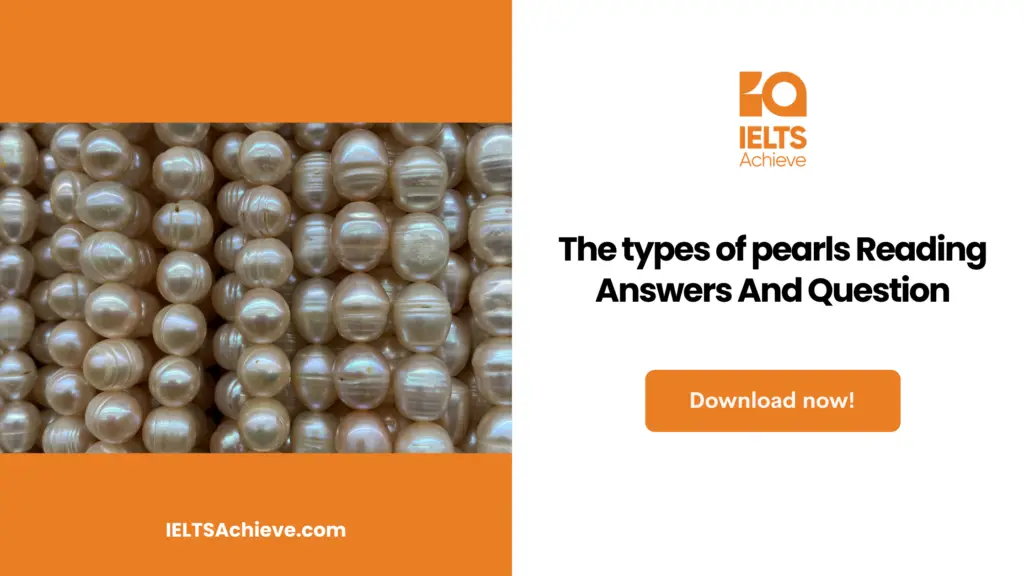The Blog post contains the following IELTS Reading Questions:
- IELTS True/False/ Not given questions
- IELTS Locating Information
- IELTS summary completion
Stay informed and prepared for success – Explore our comprehensive Reading Test Info page to get valuable insights, exam format details, and expert tips for mastering the IELTS Reading section.
IELTS reading passage – The types of pearls

The types of pearls
Throughout history, pearls have held a unique presence within the wealthy and powerful. For instance, the pearl was the favoured gem of the wealthy during the Roman Empire. This gift from the sea had been brought back from the orient by the Roman conquests. Roman women wore pearls to bed so they could be reminded of their wealth immediately upon waking up. Before jewellers learned to cut gems, the pearl was of greater value than the diamond. In the Orient and Persia Empire, pearls were ground into powders to cure anything from heart disease to epilepsy, with possible aphrodisiac uses as well. Pearls were once considered an exclusive privilege for royalty. A law in 1612 drawn up by the Duke of Saxony prohibited the wearing of pearls by the nobility, professors, doctors or their wives in an effort to further distinguish royal appearance. American Indians also used freshwater pearls from the Mississippi River as decorations and jewellery.
There are essentially three types of pearls: natural, cultured and imitation. A natural pearl (often called an Oriental pearl) forms when an irritant, such as a piece of sand, works its way into a particular species of oyster, mussel, or clam. As a defense mechanism, the mollusk secretes a fluid to coat the irritant. The layer upon layer of this coating is deposited on the irritant until a lustrous pearl is formed.
The only difference between natural pearls and cultured pearls is that the irritant is a surgically implanted bead or piece of shell called Mother of Pearl. Often, these shells are ground oyster shells that are worth significant amounts of money in their own right as irritant-catalysts for quality pearls. The resulting core is, therefore, much larger than in a natural pearl. Yet, as long as there are enough layers of nacre (the secreted fluid covering the irritant) to result in a beautiful, gem-quality pearl, the size of the nucleus is of no consequence to beauty or durability.
Pearls can come from either salt or freshwater sources. Typically, saltwater pearls tend to be higher quality, although there are several types of freshwater pearls that are considered high in quality as well. Freshwater pearls tend to be very irregular in shape, with a puffed rice appearance, the most prevalent. Nevertheless, it is each individual pearl’s merits that determines value more than the source of the pearl. Saltwater pearl oysters are usually cultivated in protected lagoons or volcanic atolls. However, most freshwater cultured pearls sold today come from China. Cultured pearls are the response of the shell to a tissue implant. A tiny piece of mantle tissue from a donor shell is transplanted into a recipient shell. This graft will form a pearl sac and the tissue will precipitate calcium carbonate into this pocket. There are a number of options for producing cultured pearls: use freshwater or seawater shells, transplant the graft into the mantle or the gonad, add a spherical bead or do it non-beaded. The majority of saltwater cultured pearls are grown with beads.
Regardless of the method used to acquire a pearl, the process usually takes several years. Mussels must reach a mature age, which can take up to 3 years, and then be implanted or naturally receive an irritant. Once the irritant is in place, it can take up to another 3 years for the pearl to reach its full size. Often, the irritant may be rejected, the pearl will terrifically misshapen, or the oyster may simply die from disease or countless other complications. By the end of a 5 to 10-year cycle, only 50% of the oysters will have survived. And of the pearls produced, only approximately 5% are of substantial quality for top jewellery makers. From the outset, a pearl farmer can figure on spending over $100 for every oyster that is farmed, of which many will produce nothing or die.
Imitation pearls are a different story altogether. In most cases, a glass bead is dipped into a solution made from fish scales. This coating is thin and may eventually wear off. One can usually tell an imitation by biting on it. Fake pearls glide across your teeth, while the layers of nacre on real pearls feel gritty. The Island of Mallorca (in Spain) is known for its imitation pearl industry. Quality natural pearls are very rare jewels. The actual value of a natural pearl is determined in the same way as it would be for other “precious” gems. The valuation factors include size, shape, and colour, quality of surface, orient, and lustre. In general, cultured pearls are less valuable than natural pearls, whereas imitation pearls almost have no value. One way that jewellers can determine whether a pearl is cultured or natural is to have a gem lab perform an x-ray of the pearl. If the x-ray reveals a nucleus, the pearl is likely a bead-nucleated saltwater pearl. If no nucleus is present, but irregular and small dark inner spots indicating a cavity are visible, combined with concentric rings of organic substance, the pearl is likely a cultured freshwater. Cultured freshwater pearls can often be confused for natural pearls which present as homogeneous pictures that continuously darken toward the surface of the pearl. Natural pearls will often show larger cavities where organic matter has dried out and decomposed. Although imitation pearls look the part, they do not have the same weight or smoothness as real pearls, and their luster will also dim greatly. Among cultured pearls, Akoya pearls from Japan are some of the most lustrous. A good quality necklace of 40 Akoya pearls measuring 7 mm in diameter sells for about $1,500, while a super- high-quality strand sells for about $4,500. Size, on the other hand, has to do with the age of the oyster that created the pearl (the more mature oysters produce larger pearls) and the location in which the pearl was cultured. The South Sea waters of Australia tend to produce the larger pearls; probably because the water along the coastline is supplied with rich nutrients from the ocean floor. Also, the type of mussel common to the area seems to possess a predilection for producing comparatively large pearls
Historically, the world’s best pearls came from the Persian Gulf, especially around what is now Bahrain. The pearls of the Persian Gulf were naturally created and collected by breath-hold divers. The secret to the special lustre of Gulf pearls probably derived from the unique mixture of sweet and saltwater around the island. Unfortunately, the natural pearl industry of the Persian Gulf ended abruptly in the early 1930s with the discovery of large deposits of oil. Those who once dove for pearls sought prosperity in the economic boom ushered in by the oil industry. The water pollution resulting from spilt oil and indiscriminate over-fishing of oysters essentially ruined the once pristine pearl-producing waters of the Gulf. Today, pearl diving is practised only as a hobby. Still, Bahrain remains one of the foremost trading centres for high-quality pearls. In fact, cultured pearls are banned from the Bahrain pearl market, in an effort to preserve the location’s heritage. Nowadays, the largest stock of natural pearls probably resides in India. Ironically, much of India’s stock of natural pearls came originally from Bahrain. Unlike Bahrain, which has essentially lost its pearl resource, traditional pearl fishing is still practised on a small scale in India.
Unlock your full potential in the IELTS Reading section – Visit our IELTS Reading Practice Question Answer page now!
Recommended Questions:
Renewable Energy IELTS Reading Question with Answer
Questions
Questions 1-4
Choose the paragraph that contains the following information.
Write the correct letter of the paragraph in boxes 1-4 on your answer sheet.
1. Past stories about the pearls and its users
2. Difficulties in producing pearls
3. Ways to check the value of natural pearls
4. Process to differentiate cultural pearls from natural pearls
Questions 5-10
Complete the summary with a maximum of two words for each answer.
Write the correct answer in boxes 5-10 on your answer sheet.
In the historical period, pearls were of great importance among powerful and wealthy men and were used as precious stones for women in (5)………….. Pearls were also used as a remedy by the people of (6)………….. The pearls are categorized into three types namely: imitation pearls, cultured pearls, and natural pearls. China is known for the freshwater cultured pearls and the imitation pearl industry is situated in (7)………….. Island. Good quality natural pearls are very rare. Some of the shiniest pearls are manufactured in (8)………….. while (9)………….. produces large-size pearls because of the favorable environmental conditions near the shore. In ancient times, the best quality pearls were produced in (10)………….. in the Persian Gulf. These days, India has the highest amount of natural pearls.
Boost your performance in Summary, Notes, Table, and Flowchart Completion tasks. Click here to explore our detailed guide and learn how to effectively complete summaries, notes, tables, and flowcharts in the IELTS Reading section.
Questions 11-13
Check whether or not the below statements agree with the passage.
#solution-for-the-types-of-pearls
Write True/ False/ Not Given in boxes 11-13 on your answer sheet.
11. In general, cultured pearls have a larger center than natural pearls.
12. At times, real pearls can be less expensive than fake ones.
13. The pearls of Japan are smaller than those of Australia.
Enhance your skills in identifying information as True, False, or Not Given. Click here to discover expert strategies and techniques for mastering this question type in the IELTS Reading section.
Unlock your full potential in the IELTS Reading section – Visit our IELTS Reading Practice Question Answer page now!
Recommended Questions:
Renewable Energy IELTS Reading Question with Answer
Answers for The types of pearls
1. Answer: A
2. Answer: E
3. Answer: G
4. Answer: C
5. Answer: ANCIENT ROME
6. Answer: PERSIA
7. Answer: MALLORCA
8. Answer: JAPAN
9. Answer: AUSTRALIA
10. Answer: BAHRAIN
11. Answer: TRUE
12. Answer: NOT GIVEN
13. Answer: TRUE

We hope you found this post useful in helping you to study for the IELTS Test. If you have any questions please let us know in the comments below or on the Facebook page.
The best way to keep up to date with posts like this is to like us on Facebook, then follow us on Instagram and Pinterest. If you need help preparing for the IELTS Test, join the IELTS Achieve Academy and see how we can assist you to achieve your desired band score. We offer an essay correction service, mock exams and online courses.

